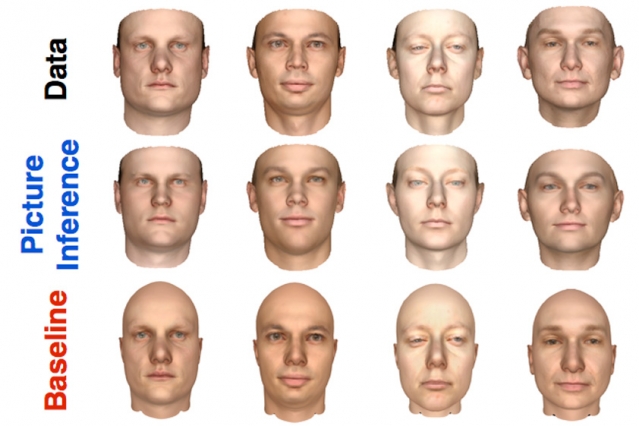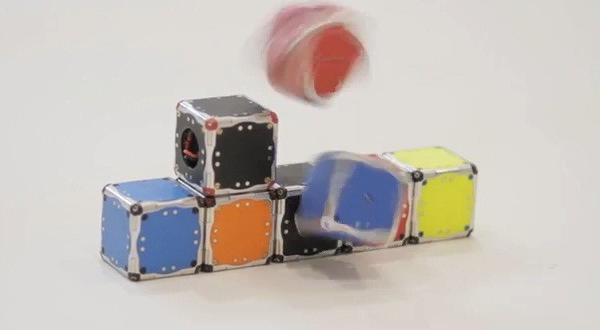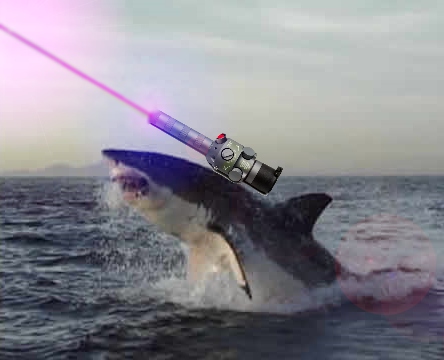A brief comment about affect, technology, and the Uncanny Valley

By ‘brief,’ I apparently meant ‘very long.’
While researching another post recently, I came across several articles describing some research going on at MIT as “creepy.” There’s this one from Wired that discusses MIT’s research into probabilistic code, which reduces code by offloading the process of writing algorithms to a set of pre-written general algorithms. It’s described as creepy because it shows how this reduced code an still derive 3-D modeled faces from 2-D images.
Impressive, and not terribly off-putting to me, although I can understand how some might skip the amazing development of the code structure in the first place and jump right to creepy.
Another article from the L.A. Times discusses small, acrobatic, self-assembling cubes as creepy. I’m not sure what’s creepy about these either, and to be fair the author postulates in the title of the post itself that they could be also be considered as ‘cute.’
The Core77 blog refers to MIT’s autonomous robotic fish as creepy, apparently because it behaves exactly as a fish. It’s quite nifty in its ability to swim, and, frankly, operate underwater; a normally hostile environment for electronics. Here’s a video of it functioning, as well as a picture of a shark with a laser on its head from the blog post. I included the picture because IT’S A SHARK WITH A LASER ON ITS HEAD!
Although I’m hardly out of examples, I’ll make this the final one before getting to the point: Popular Science went so far as to emphasize the creepy nature of MIT’s fascinating cheetah robot by stating “Not creepy at all.”
Again, as with the others I don’t find it, or its also oft-decribed-as-creepy big brother-from-another-company Big Dog to be abnormally creepy, but that’s just me. Maybe I’m weird, but I think they’re both quite incredible in terms of what they can do; in the case of the cheetah it can run faster than any robot, while the dog can regain its footing after being set off-balance.
Here are some videos. The Cheetah has recently been taught to jump! Also, make sure to note the sympathy you feel for Big Dog as a researcher tries to kick it over – that will be important.
This is an older implementation of the Big Dog, it has since been improved and renamed.
So what’s the point of all this? It is an examination of what makes us refer to something no-human or non-animal as ‘creepy.’
We talk about this in class, however the fundamental issue is what’s known as the Uncanny Valley, a term coined over forty years ago. The gist of it is that when something that is clearly not human exhibits human characteristics, we find it endearing. A common example is when a dog exhibits some behavior that we find similar to the behavior of a person, we say “Aw, he thinks he’s people!” He doesn’t think he’s people, but we humanize it in that way. In robotics, we do the same thing for R2-D2; he’s a cute robot that we always root for, and if he gets ‘injured’ we feel sympathy. When something is clearly not human, we notice its human characteristics in an endearing way.
However, as something non-human gets closer and closer to appearing human, we begin to notice its *non*-human characteristics. We notice what’s wrong with it, its odd behaviors and patterns, the lack of a ‘spark’ that indicates life and humanity. That leads us to withdraw, to be repulsed by the thing that appears human but clearly isn’t. We aren’t drawn to it, we are severely repelled by it.
Incidentally, this isn’t an issue of device-based affect, such as when you say something along the lines of “I love this phone!” We’ve all done that, of course, but that is a separate, yet equally fascinating, issue.
The example I use in class, which many of you have already seen, is the ‘CreepyGirl.’ She was actually developed by MotionPortrait, and based on a real individual. When she is shown in class, it’s common for the reaction to be negative. Here’s a screenshot of the site, and you can see what the issue might be. She is animated and responds to the mouse cursor, which adds to the reaction.
To watch her animate, one could be forgiven for not exclaiming the amazing technology that underlies her existence. However, because she looks human, her awkward, stilted movements make her appear more like a zombie and people focus on that as opposed to her human-like characteristics.
On the other hand, if it were a robot and not a lifelike human, the reaction would likely be quite the opposite; amazement and how it moves sort-of like a human.
This is a very difficult valley for designers and roboticists to cross. Most attempts are awkward and uncomfortable, even if the facial features are lifelike. Human behaviors and mannerisms are very, very difficult to create. Even artificial intelligence, in the form of deep learning, has advanced far beyond the physical issues still prevalent in the design of robots (possibly to the demise of us all!).
If we ever get replicants as they had in Blade Runner, perhaps this will no longer be an issue (same for Terminators, altho0ugh I’d prefer replicants). For now, however, it is the biggest and most unexpected hurdle for robots to be accepted into society.




